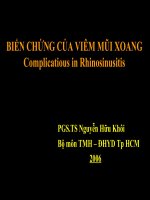bien chung viem mui xoang
Bạn đang xem bản rút gọn của tài liệu. Xem và tải ngay bản đầy đủ của tài liệu tại đây (130.3 KB, 12 trang )
BIẾN CHỨNG CỦA VIÊM MŨI XOANG
Complicatious in Rhinosinusitis
PGS.TS Nguyễn Hữu Khôi
Bộ môn TMH – ĐHYD Tp HCM
2006
Complicatious in Rhinosinusitis
• Preantibiotic Era: BC mắt thường xảy ra.
Trong số này có 17% Meningitic, 20% Blindness.
• Thời đại KS: BC ít gặp, vẫn có BC nặng / tử
vong.
• Điều kiện xảy ra BC:
- Med.Treatment: inadequate
- Host immunity: impaired.
- Organisms: Virulent & resistant.
- Surgical Intervention: delayed.
• Mũi xoang
Cận kề
Viêm - Biến chứng
Mắt - Não
Orbital Complications
• Orbit: close proximity to the sinus
Medially: Ethmoid & Sphenoid Sinus.
Superiorly: Frontal.
Inferiorly: Maxillary.
• Prevalent: Children > Aldults
• VX gây BC: 1
st
Ethmoid Simusittis
2
st
Frontal / Maxillary
3
st
Sfhenoid ±
Orbital Complications
Thành ngoài xoang sàng (xương giấy) và thành ngoài
xoang bướm ngăn cách với ổ mắt: rất dễ bị tổn thương gây
biến chứng cho ổ mắt và dây thần kinh thị giác
ORBITAL EXTENSION OF SINUSITIS
Two routes
1. Direct Extension
- Through emgenital body dehischices.
open suture liues / foramina.
- By erosion of the bony barrier. Lamina papyracea
2. Retrograde Thromb phlebitis.
• Rich network of valveless veines.
( face, nasalcarity, Sinus = orbit)
• Arterial spread: possible / imlikely.
• Lymphatics: absent in the orbit.
ORBITAL COMPLICATIONS OF SINUSITIS
1. Periorbital Cellulitis.
Inflammatory Edema of the Eyelid.
2. Orbital Cellulitis.
Inf. & Edema of orbital Conthits.
3. Subperiosteal Abscess: Collection of pus
between periorbi & bony orbital wall.
4. Orb. Abscess: Collection of pus in the Orb.
5. Cavernous sinus Thrombosis.
6. Loss of Vision.
ORBITAL CELLULITIS
• Diffuse Inflammation & Edema.
of the orbital Contents without Abscess.
• Proptosis, chemosis, ophthalmoplegia.
chemosis: conjunctival Edema.
( Secondary, obstruction of oph. Veines )
• Untreated Abscess & Blindness.
SUBPERIOSTEAL ABSCESS
• Collection of pus:Orb. Periosteum//bony orb.wall
• Orbital contents: displaced in ferolaterally.
Chemosis, ocular Mobility
• Abscess penetrate:
Laterally Orbit
Anteriorly Eyelid
ORBITAL ABSCESS
• Collection of Pus in the orbital Tissue.
Extraconal: Periosteum // Muscle
in traconal, centrally within the musle cone
• Mecanism
- Result of progoenion of orb. Cellulitis.
- Spread of infection from subperiosteal abscess.
• Symptoms: Proptosis, visual loss
Limitation of extraocular Movement
CAVERNOUS SINUS THROMBOSIS
• Source of Infection: Ethmoid, sphenoid/often
• Direct extension / Retrograd thrombophlebitis
• Early symptoms: Fever, Headach, Photophobia
Diplopia, periorbital Edema.
• Classic findings: Ptosis, Proptosis, Chemosis
ocular palsy, Visual Acuity
• Hallmark of CST: Bilateral ocular symptoms
• Neve II – VI, Pituitany, Meningitis
cerebral abscess
LOSS OF VISION
1. Temporary or permanent
± funduscopic abnormalities.
2. Pathophysiology of decreased Vision.
• Ischemic optic neuropathy.
• Compressive optic neuropathy ( ethmoiditis )
• Inflammatory optic neuropathy.
INTRACRANIAL COMPLICATIONS
• Acute Sinusitic or acute exacerbation of CS
• Frontal: most common
ethmoid, sphenoid, maxillary
• Antibiotics: not changed the incidence of Sinusitis
decreased the frequency of complications
• Most serious intracranial complications:
Osteomyelitis, Epidural Abscess, Subdural Empyema
Superior sagittal Sinus & Cavernous S. Thrombosis
Meningitis & Intracranial Abscess









